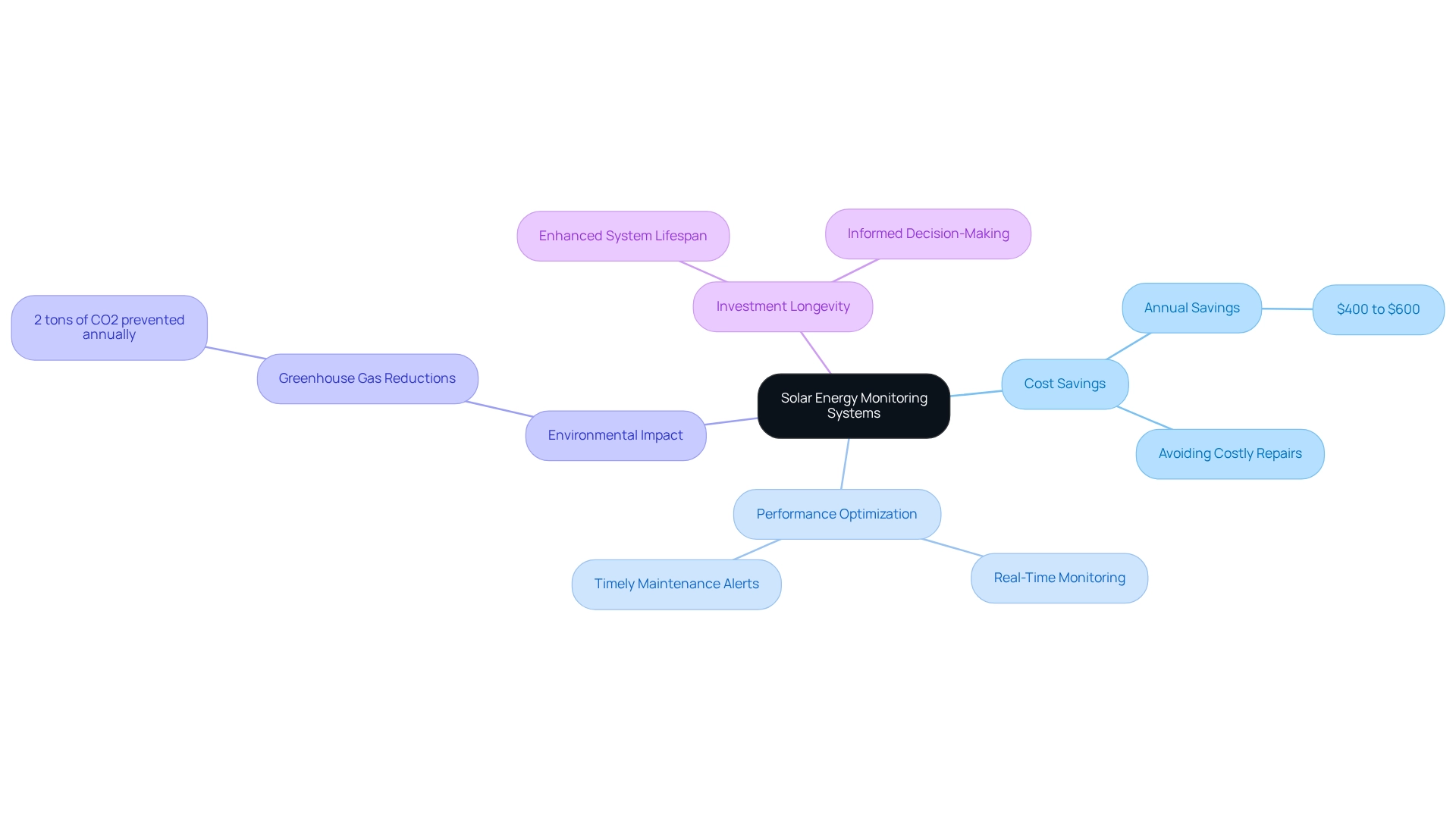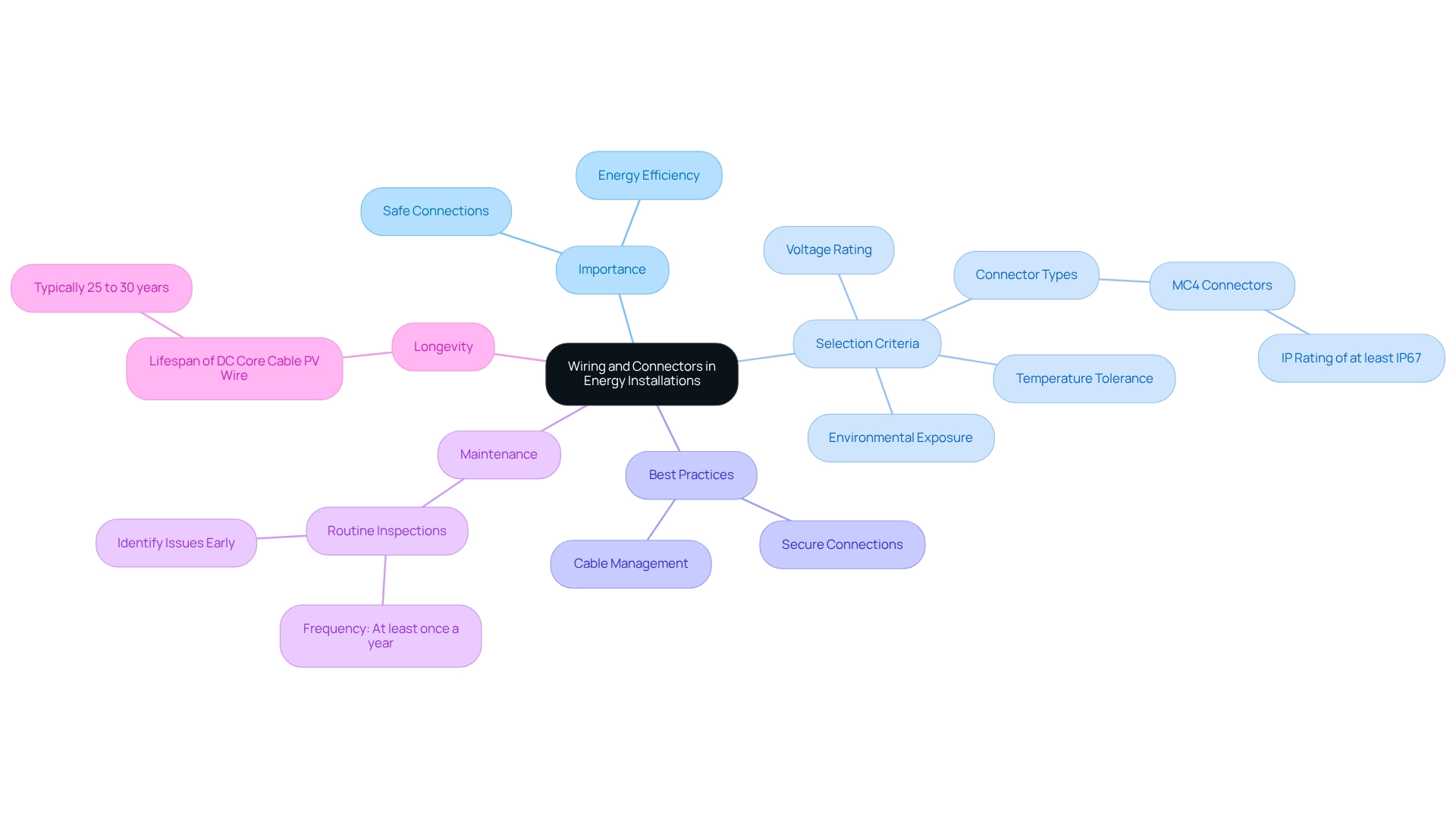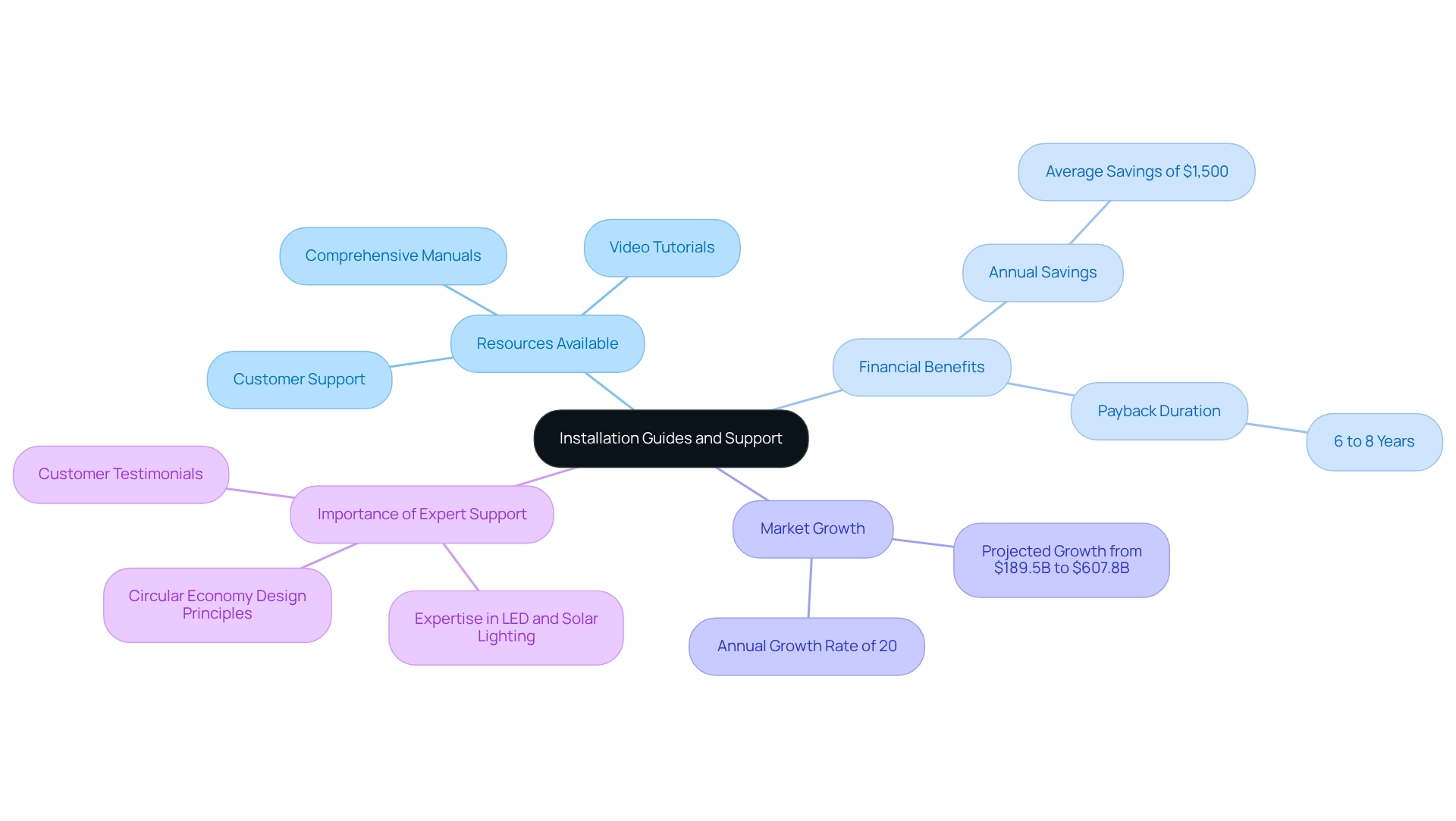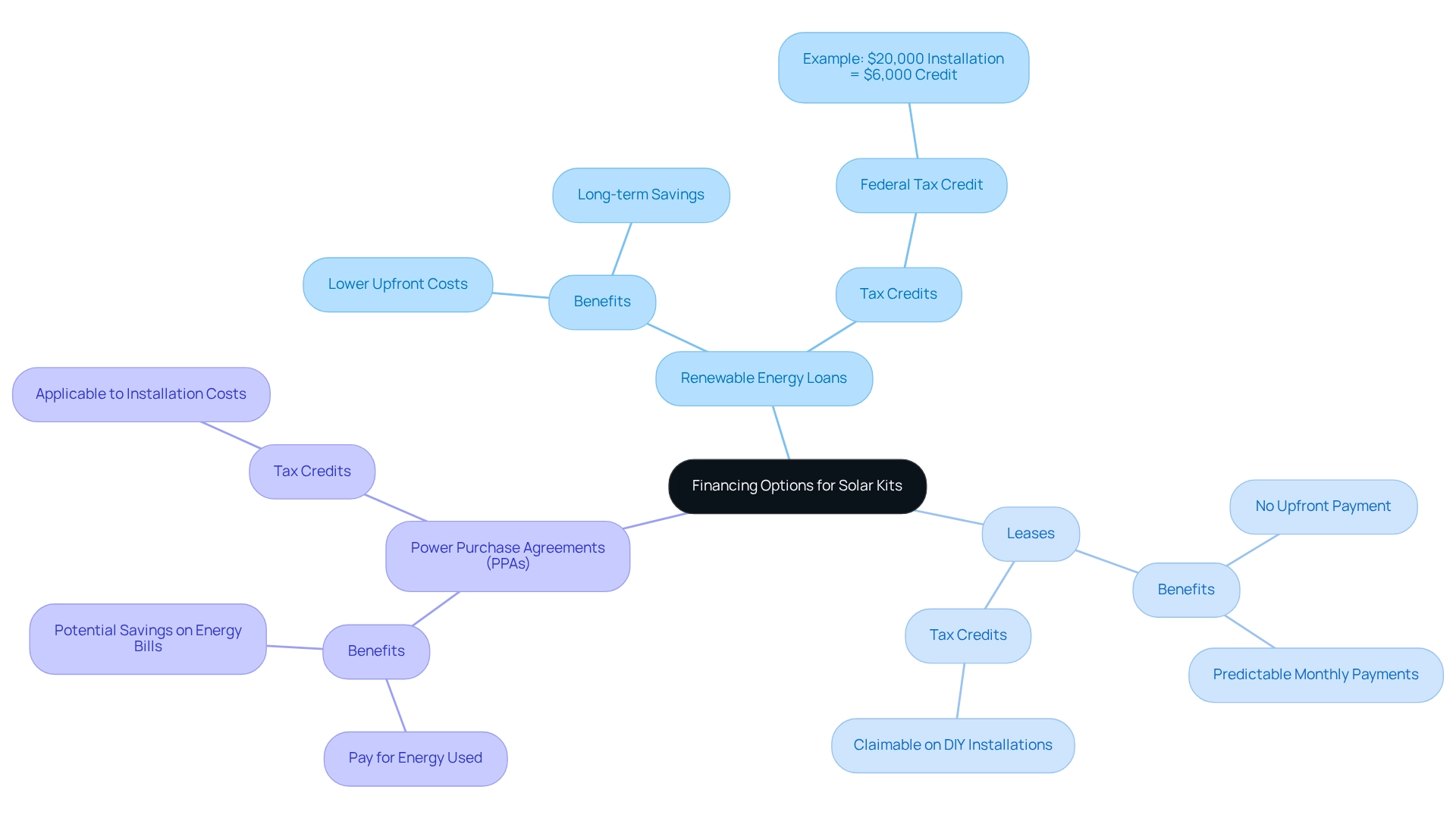Overview
Are you feeling overwhelmed by rising energy bills? You’re not alone. Many homeowners share your concerns, and that’s where a solar kit can make a significant difference. The essential components of a DIY solar kit include:
- Photovoltaic panels
- Inverters
- Battery storage systems
- Racking systems
- Monitoring systems
- Wiring and connectors
- EV chargers
Each of these components plays a vital role in optimizing energy efficiency, ensuring safe installation, and enhancing overall performance. By investing in solar energy, you can take a meaningful step towards energy independence, making it more accessible and affordable for you to reduce both your energy costs and environmental impact. Together, we can create a sustainable future. If you’re ready to explore how solar energy can benefit you, let’s work towards a solution that meets your needs.
Introduction
In our journey towards sustainable living, many homeowners are understandably concerned about rising electricity costs and their impact on the environment. We recognize these challenges and want to share how solar energy can be a compassionate solution, offering not just relief from high bills but also a way to reduce your carbon footprint.
Powercore Electric is here to support you in this transition, providing a diverse range of DIY solar kits that empower you to harness the sun’s energy effectively. With over three decades of experience in the solar industry, we offer not just essential components like solar panels and inverters, but also the comprehensive support you need for a seamless installation experience.
As the trend towards renewable energy continues to grow—projected to see a significant rise in solar adoption across the U.S.—these kits represent a practical and cost-effective pathway for eco-conscious homeowners eager to embrace energy independence. Together, we can contribute to a greener future and create a more sustainable world.
We invite you to explore how these solutions can work for you and how we can assist you on this important journey.
Powercore Electric DIY Solar Kits: Comprehensive Solutions for Homeowners
At Powercore Electric, we understand that rising energy bills can be a significant concern for homeowners. That’s why we offer an extensive selection of solar kit DIY products specifically designed for property owners eager to harness renewable resources effectively. Each kit includes essential components such as photovoltaic panels, inverters, mounting hardware, and wiring, ensuring a simple installation and maintenance process. With over 30 years of experience in the photovoltaic sector, we empower residents to take control of their energy usage and significantly reduce their electricity expenses.
Recent data shows a growing trend among California residents embracing renewable power solutions, with forecasts indicating that by 2050, up to 36% of U.S. residential structures will be powered by such technologies. This shift highlights the increasing appeal of solar kit DIY, which offers a practical and economical pathway for homeowners to transition to renewable sources. Our solar kit DIY is thoughtfully designed to address the specific power needs of environmentally conscious homeowners, making renewable energy both attainable and feasible. The advantages of these kits include:
- Lower utility costs
- Independence from traditional power sources
- The opportunity to contribute to a sustainable future
As demand for solar kit DIY energy solutions continues to rise, it reflects a nationwide commitment to renewable resources. By incorporating insights from industry experts, we ensure that each solar kit DIY is effective and aligns with the latest trends in the energy market. Homeowners can invest in these kits with confidence, knowing they are supported by a company dedicated to transparency and quality service.
Furthermore, we offer throughout Northern and Southern California, assisting residents in tackling while enjoying the benefits of autonomy and financial savings. For those considering photovoltaic solutions, understanding the available tax incentives can further enhance the financial advantages of transitioning to renewable power. Together, let’s explore how you can make a sustainable choice for your home—reach out to Powercore Electric today for a free personalized estimate.
Solar Panels: The Core Component of Your DIY Solar Kit
As eco-conscious homeowners, we understand your concerns about rising energy bills and the impact of traditional power sources on our planet. Solar heating solutions can be a cornerstone in your journey towards harnessing solar energy efficiently. These systems transform sunlight into usable heat, and are vital indicators of performance. High thermal efficiency means that your system can convert sunlight into heat effectively, maintain consistent temperatures despite changing weather, and help reduce your operational expenses. Imagine saving between $400 to $600 annually on utility costs with solar water heating devices. Moreover, by adopting these frameworks, you significantly lessen your dependence on conventional power sources, which in turn reduces greenhouse gas emissions and fosters sustainability. The Environmental Protection Agency indicates that utilizing energy-efficient water heating can prevent 2 tons of carbon dioxide from entering the atmosphere each year—equivalent to not operating a vehicle for four months.
Understanding the metrics for thermal efficiency, such as energy output compared to energy input, is essential when selecting a renewable heating solution. We recognize that navigating these choices can feel overwhelming, but expert insights emphasize the importance of efficiency testing to ensure high-quality heating systems are available in the market. Investing in a high-efficiency heating solution not only contributes to a healthier planet but also represents a financially sound choice for long-term savings. Together, we can make a difference for both your wallet and the environment.
Inverters: Essential for Converting Solar Energy to Electricity
Inverters are essential components of energy kits, transforming the DC electricity generated by solar panels into AC electricity that powers most home appliances. When considering inverters, it’s important to understand the primary types available: string inverters, microinverters, and power optimizers. Many homeowners prefer string inverters for their simplicity and cost-effectiveness. However, microinverters can enhance performance by maximizing the output of each individual panel, which is especially beneficial in partially shaded areas.
We understand that choosing the right inverter can feel overwhelming. It’s crucial to consider factors such as size, efficiency ratings, and compatibility with your photovoltaic panels. Recent advancements in inverter technology have led to significant performance improvements. For instance, the latest modular inverter units have reduced installation times and improved control precision at the panel level, leading to less energy loss and increased power output.
As of 2023, the International Energy Agency reported that around 7 GW of residential photovoltaic technology was installed, marking the fifth consecutive record year for this segment. This trend underscores the growing importance of efficient inverter technology in home energy solutions. Homeowners are increasingly recognizing the vital role of inverters—not only for their power conversion capabilities but also for their impact on overall efficiency and reliability. With photovoltaic modules typically lasting between 20 to 40 years, investing in high-quality inverters is essential for ensuring long-term savings and sustainability.
Moreover, property owners should think about the type of setup they wish to adopt, whether grid-connected or off-grid, as this decision will influence . The rising trend of grid-connected photovoltaic inverter setups, particularly in Europe where about 27% of schools and municipal centers have adopted them, highlights the potential for significant power savings and efficiency improvements. Additionally, government initiatives aimed at promoting photovoltaic solutions can provide financial incentives, making it easier for homeowners to invest in quality installations.
By understanding the advantages of different inverter types and their compatibility with various photovoltaic systems, homeowners can make informed choices that align with their energy needs and sustainability goals. Furthermore, pairing photovoltaic panel functionality with optimal battery selections and considering panel cleaning services can enhance the overall effectiveness of renewable energy solutions, ensuring that residents maximize their investment in sustainable resources. Together, we can work towards a more energy-independent future, where your home not only meets your energy needs but also contributes positively to the environment.
Battery Storage Systems: Maximizing Energy Independence
We understand that rising energy bills can be a significant concern for homeowners, prompting a search for sustainable solutions. Battery storage solutions play a crucial role in enhancing power autonomy, allowing you to retain surplus solar power generated during the day for use at night or during outages. Lithium-ion batteries are particularly favored for their efficiency, compact size, and reliability. When considering a battery storage solution, it’s essential to evaluate aspects such as capacity, discharge rate, and warranty options. Typically, the average capacity of lithium-ion batteries ranges from 5 kWh to 15 kWh, with discharge rates varying significantly based on the model and manufacturer.
Recent advancements in battery storage technology have further increased their appeal. In 2025, more California homeowners are adopting these systems, driven by the need for dependable power sources amid rising electricity costs. A significant legislative milestone includes California’s recent bill allowing vehicle-to-grid (V2G) and vehicle-to-home (V2H) bidirectional charging, integrating electric vehicles, such as Tesla home chargers, into the power grid. This initiative supports clean power objectives, and Governor Gavin Newsom has emphasized it as a ‘significant triumph on the journey to 100% clean electricity,’ highlighting the importance of such technologies in achieving sustainable power solutions.
Homeowners who have embraced lithium-ion battery storage in their energy setups report notable advantages, including reduced dependence on the grid and enhanced resilience during outages. These systems not only provide backup power but also contribute to a more sustainable energy future. Moreover, government initiatives promoting renewable energy, alongside planned for implementation in California and Texas—such as the Bellefield Solar and Storage Farm—underscore the growing trend and investment in battery storage solutions. As the demand for power storage alternatives increases, the durability and effectiveness of lithium-ion batteries make them an ideal choice for those seeking to enhance their renewable energy setups. Together, we can explore how these solutions can empower your energy independence, fostering a brighter, more sustainable future.
Racking Systems: Secure Your Solar Panels Effectively
We understand that rising energy bills can be a source of concern for many homeowners. Racking structures play a crucial role in , ensuring their stability and efficiency in diverse weather conditions. Various types of racking structures are available, including:
- Fixed tilt
- Adjustable tilt
- Ground mounts
Fixed tilt setups are the most common for residential installations due to their simplicity and affordability. On the other hand, adjustable tilt mechanisms allow for optimizing panel angles according to seasonal sun positions, potentially enhancing power capture by up to 19.52% compared to fixed setups.
It’s common to feel overwhelmed when considering installation. It is vital to adhere to manufacturer guidelines and local building codes to guarantee safety and compliance. Homeowners should also be aware that while tracking mounts can maximize energy production, they typically come at a higher cost than stationary mounts. Furthermore, requesting particular mounting solutions beyond conventional choices may result in higher installation costs, which can affect total project budgets.
Expert opinions highlight the significance of secure installations, as improper mounting can lead to damage and reduced efficiency. As mentioned by industry specialists, “Secure installations are crucial for enhancing the lifespan and efficiency of renewable energy solutions.” Powercore Electric’s in-house team of experts exemplifies this commitment to quality, ensuring high standards in installation and maintenance. With advanced, cost-effective energy solutions customized to your requirements, Powercore Electric establishes itself as a reliable option for residents seeking to adopt efficient energy alternatives. By choosing the appropriate shelving solution, environmentally aware property owners can improve efficiency and realize long-term financial benefits. Together, we can work towards a brighter, more sustainable future.
Monitoring Systems: Track Your Solar Energy Production
Monitoring setups are essential for effectively addressing your concerns about energy bills and ensuring the performance of your renewable power installation. These sophisticated systems provide real-time information on energy generation, enabling you to quickly identify issues and optimize your energy usage. Many modern solar kit DIY products come equipped with , accessible through user-friendly smartphone applications or online platforms. Regularly reviewing your system’s performance not only guarantees it operates at peak efficiency but also facilitates timely maintenance, ultimately enhancing the longevity and effectiveness of your investment.
In California, where nearly 40 percent of electricity was generated from photovoltaic energy as of March 2025, the importance of monitoring cannot be overstated. As Mike Williams noted, “With the cost of power continually increasing, utilizing renewable energy gives you the ability to manage rising costs and fosters positive public relations by choosing to go green in your operations.” By employing these setups, property owners can avoid costly repairs and gain valuable insights into their renewable investments, reinforcing their commitment to sustainable resources.
Moreover, the efficiency of heating systems significantly contributes to cost savings, with projections suggesting that residents can save between $400 to $600 each year on energy expenses. The case study titled ‘Importance of Solar Monitoring‘ illustrates how monitoring mechanisms alert property owners to production declines, allowing for timely maintenance and optimizing power usage, which ultimately enhances the financial returns of their renewable investments. Additionally, these technologies play a crucial role in reducing greenhouse gas emissions, with water heating devices capable of preventing 2 tons of carbon dioxide from entering the atmosphere annually. As awareness of the benefits of monitoring tools grows, homeowners can optimize power generation and savings, transforming these solutions from a luxury into a necessity in the evolving photovoltaic market.
Wiring and Connectors: Ensure Safe and Effective Installation
Wiring and connectors are essential components of any energy kit, and they play a vital role in ensuring safe and effective connections throughout your setup. We understand that many homeowners are concerned about energy bills, and selecting the right photovoltaic cables can significantly impact your energy efficiency. It’s crucial to consider factors such as voltage rating, temperature tolerance, and environmental exposure. By utilizing high-quality, weather-resistant cables and connectors—like MC4 connectors with an IP rating of at least IP67—you can prevent electrical issues and enhance the longevity of your installation. This thoughtful approach not only boosts the functionality of photovoltaic panels but also optimizes energy storage solutions, ensuring that your setup operates efficiently.
Proper wiring practices are paramount. Secure all connections and manage cable runs carefully to avoid damage and maintain efficiency. We recommend , ideally scheduled at least once a year, to prolong the lifespan of your cables. These inspections can help identify potential issues, such as cracks or loose connections, early on, preventing major failures and ensuring that your energy system operates smoothly. A case study underscores the importance of regular upkeep for photovoltaic cables, showing that proactive inspections can significantly reduce risks. Remember, the lifespan of DC Core Cable PV Wire typically lasts 25 to 30 years, highlighting the long-term benefits of investing in quality wiring.
As you prepare for your installation, consider current standards for wiring and connectors, and seek expert insights on best practices. Homeowner experiences emphasize that attention to detail in wiring can greatly influence the overall performance and reliability of renewable energy installations. By prioritizing high-quality wiring and connectors—including those with an average lifespan of weather-resistant cables and connectors in photovoltaic systems—you can ensure a safe, efficient, and durable power solution for your home. Together, let’s work towards a more sustainable and energy-independent future.
EV Chargers: Enhance Your Solar Kit with Electric Vehicle Charging
Are you concerned about rising energy bills? Incorporating EV chargers into your photovoltaic system can significantly improve its functionality, allowing you to power your electric vehicle (EV) with the clean energy produced by your panels. In California, approximately 30% of homeowners are already utilizing EV chargers, reflecting a growing trend towards sustainable energy solutions. By pairing numerous photovoltaic arrays with Level 2 EV chargers, you can enjoy quicker charging durations and enhanced efficiency.
When selecting an EV charger, it’s essential to consider:
- How it aligns with your energy system
- The charging speed
- The installation requirements
The latest developments in EV charger technology for 2025 emphasize intelligent charging features, enabling homeowners to optimize their power consumption according to generation patterns. This thoughtful integration not only lowers your carbon footprint but also maximizes the use of your renewable energy, leading to substantial savings on utility expenses and improving your energy independence.
Current trends indicate that 78% of installers anticipate higher sales in 2025, driven by the increasing demand for integrated renewable energy and EV charging solutions. By calculating your savings based on:
- The kilowatt-hours (kWh) of EV charging annually
- The proportion of charging sourced from clean energy
- The price difference of such energy
Homeowners can truly benefit from . This approach can lead to significant annual savings while supporting a shift towards more sustainable living practices.
Moreover, solar water heaters enhance renewable power setups by providing effective hot water options, further improving resource savings and sustainability. These systems can heat water to elevated temperatures using sunlight, significantly reducing reliance on non-renewable power sources. Many areas offer incentives or rebates for installing solar-powered water heating systems, making them an appealing choice for environmentally conscious residents.
Real-world case studies reveal that individuals who charge their EVs during peak sunlight generation hours can optimize their use of renewable power. For instance, a study titled “Impact of EV Charging on Solar Energy Utilization” shows that residents can greatly enhance their savings by synchronizing their EV charging practices with periods of renewable energy generation. By selecting the appropriate EV charger for your renewable setup, you not only improve your power efficiency but also contribute to a more sustainable future.
As Ben Zientara, a renewable energy policy analyst, observes, “The combination of EV chargers with photovoltaic systems signifies a crucial transition towards sustainable energy practices, enabling residents to utilize the full potential of their energy investments.” At Powercore Electric, we are here to ensure that you have the right tools and support to make this integration seamless and effective, reinforcing your commitment to environmental sustainability and economic savings. Together, we can create a greener tomorrow.
Installation Guides and Support: Essential for DIY Success
Access to comprehensive installation guides and support is crucial for the success of any solar kit DIY project. We understand that managing energy bills can be a significant concern for homeowners, and that’s why Powercore Electric is here to help. We provide a variety of resources, including comprehensive manuals, video tutorials, and dedicated customer support, to assist you with the installation process of your solar kit DIY. These resources encompass essential aspects such as site assessment, system design, and step-by-step installation instructions for a solar kit DIY, ensuring that you receive expert support from start to finish.
By leveraging these guides for a solar kit DIY, you can avoid common installation errors, which can lead to inefficiencies and heightened expenses. Imagine saving around $1,500 each year on energy expenses through efficient energy systems—research shows this is possible! This highlights the financial advantages of proper installation. Furthermore, the payback duration for photovoltaic systems typically ranges from 6 to 8 years, making them a financially viable option.
As the renewable energy sector continues to expand—projected to grow from $189.5 billion in 2022 to $607.8 billion by 2030—having access to dependable installation resources for a solar kit DIY becomes increasingly important. Together, we can enhance your chances of a successful installation while contributing to a sustainable energy future. As Paul Chiao, Sales and Marketing Director at Powercore Electric, emphasizes, “Knowledgeable in , experienced in kinds of projects for residential, commercial, and municipal fields,” the importance of expert support cannot be overstated.
Additionally, Powercore Electric’s best pricing guarantee ensures that you receive affordable solutions tailored to your needs. Customer testimonials from satisfied clients who have saved significantly on their energy bills further reinforce the value of utilizing these resources. Comprehending circular economy design principles can also assist you in making sustainable selections when choosing renewable energy products, amplifying the impact of your installations. Let’s work towards a brighter, more sustainable future together.
Financing Options: Make Your Solar Kit Affordable
Funding alternatives are essential for making energy kits accessible and affordable for homeowners who may be feeling overwhelmed by rising energy costs. There are various methods available, including:
- Renewable energy loans
- Leases
- Power purchase agreements (PPAs)
Each is designed to meet different financial needs and preferences. In 2025, approximately 28% of photovoltaic installations were expanded to accommodate future electric vehicle (EV) charging, reflecting a growing trend toward power independence and sustainability. This shift can influence funding choices, as homeowners might want to consider their future energy requirements when selecting the size of their energy system and financing options.
Homeowners can significantly reduce upfront costs by taking advantage of federal tax credits and local incentives. For instance, the national renewable energy tax incentive allows property owners to claim a credit based on the installation expense, potentially saving them thousands. A $20,000 installation could yield a $6,000 tax credit, providing substantial financial support and making the transition to renewable energy more feasible. It’s also important to remember that for properties used partly for business, the maximum available credit is determined by the share of expenses allocable to nonbusiness use, which can further enhance savings for those homeowners.
Catherine Lane, a Written Content Manager, emphasizes, ‘You can claim the tax credit on a solar kit DIY installation you perform yourself,’ highlighting the benefits of DIY installations that can empower homeowners. When evaluating financing options, it’s essential to reflect on your budget, long-term savings, and overall return on investment. Consulting with a financing specialist can guide you in choosing the best option tailored to your financial situation. Many homeowners have shared positive experiences with renewable energy loans and incentives, noting that these financial tools not only alleviate the initial investment but also contribute to long-term savings on energy bills. By understanding and utilizing these financing options, homeowners can make informed decisions that align with their sustainability goals. As a next step, consider reaching out to or researching local incentives to maximize your savings together.
Conclusion
We understand that rising electricity costs can be a significant concern for homeowners. Embracing solar energy is not just a viable option—it’s becoming a necessary choice for those looking to alleviate these financial pressures while contributing to a more sustainable future. Powercore Electric’s DIY solar kits offer an accessible pathway, empowering homeowners to harness solar energy effectively, complete with all the necessary components and expert support. As the trend of solar adoption grows across the United States, these kits promise not only reduced energy bills but also foster a sense of energy independence, allowing you to take control of your energy consumption.
The integration of essential components—such as solar panels, inverters, battery storage systems, and monitoring solutions—ensures that you can optimize your solar energy system for maximum efficiency and reliability. By understanding the benefits of each component and utilizing available resources for installation and maintenance, you can enhance your overall energy production and savings.
Moreover, it’s common to feel overwhelmed by the financial aspects of transitioning to solar energy. However, the financial incentives and financing options available make this transition more attainable than ever. By leveraging federal tax credits and local incentives, you can significantly reduce upfront costs, transforming solar adoption into a financially sound investment. As the trend toward renewable energy continues to grow, now is the perfect time to explore how solar solutions can meet your individual needs and contribute to a greener, more sustainable world. Together, we can embark on this important journey towards energy independence and environmental stewardship. Engaging with experts like Powercore Electric can provide the guidance you need to make this meaningful change in your life.







